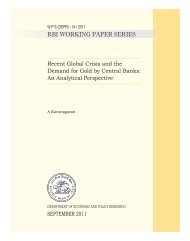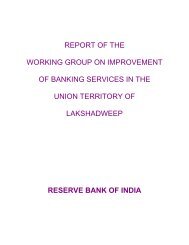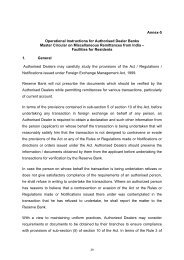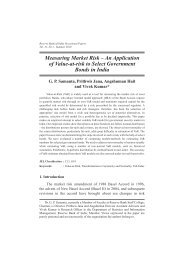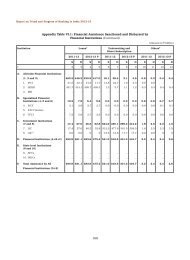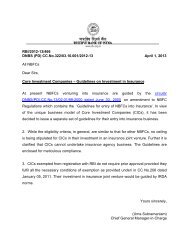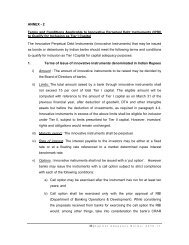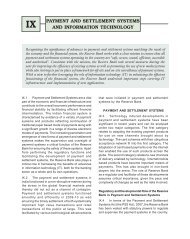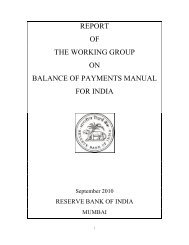Basic Statistical Returns - Reserve Bank of India
Basic Statistical Returns - Reserve Bank of India
Basic Statistical Returns - Reserve Bank of India
Create successful ePaper yourself
Turn your PDF publications into a flip-book with our unique Google optimized e-Paper software.
system as a whoie based on sources other ‘than<br />
the BSR. The figures <strong>of</strong> deposits and credit<br />
are from the returns filed by scheduled commercial<br />
banks under Section 42(2) ,<strong>of</strong> the <strong>Reserve</strong><br />
<strong>Bank</strong> <strong>of</strong> <strong>India</strong> Act, 19.34. The data on credit<br />
to priority sectors are based on special returns<br />
received from head <strong>of</strong>fices <strong>of</strong> banks.<br />
Tables 1.2 to 1.4 on deposits and credit<br />
summarise the tables given in Section 2. The<br />
data for December 1976 and 1977 are given<br />
separately for all <strong>of</strong>fices and for <strong>of</strong>fices opened<br />
after June 1969. Deposit figures exclude interbank<br />
deposits’ whereas credit comprises loans,<br />
cash credit, overdraft and bills purchased and<br />
discounted and inclusive <strong>of</strong> dues from banks<br />
and bills rediscounted under the New Bill<br />
Market Scheme.<br />
Table 1.6 brings out the differences in the<br />
regional distribution <strong>of</strong> data on credit if the<br />
same information is classified as per the district<br />
<strong>of</strong> sanction and alternatively by district <strong>of</strong><br />
utilisation, State-wise figures <strong>of</strong> credit outstanding<br />
are given according to both the location<br />
<strong>of</strong> the <strong>of</strong>fice <strong>of</strong> sanction where the account<br />
is operated and the location <strong>of</strong> the unit utilising<br />
the loan.. The. difference between the .two<br />
would indicate the extent to. which credit outstanding<br />
in the books <strong>of</strong> bank <strong>of</strong>fices in a state<br />
is utilised in other states and vice versa.<br />
Table 1‘7 gives the distribution <strong>of</strong> deposits<br />
and credit according to bank group and population<br />
group. Table 1.8 gives bank group-<br />
.wise data.on savings deposits with and without<br />
.cheque facility. This scheme was in vogue<br />
only for December 1977 survey. Table 1.9<br />
presents state-wise data on categories <strong>of</strong> staff<br />
.employed by the scheduled commercial banks.<br />
Tables 1 ,lO to 1.12 present the summary ,<strong>of</strong><br />
the data presented in Section 3.<br />
Tables 1:5 and 1.13 to 1.16 summarise the<br />
detailed classification <strong>of</strong> the data given in Section<br />
4. Tables 1.5 and 1.13 give the distribution<br />
<strong>of</strong> outstanding credit <strong>of</strong> scheduled commercial<br />
banks according to occupation and size <strong>of</strong><br />
credit limit; respectively, on the basis <strong>of</strong> accc&ntwise<br />
information given in BSR 1 - Part A<br />
and consolidated information in BSR 1 -<br />
Part B. Tables 1.14 to .I* 16, however, are<br />
,based, on information in Part A and therefore,<br />
relate cnly to accounts with credit iimit <strong>of</strong> over<br />
Rs.‘lp,OOO. The total amount <strong>of</strong> credit covered<br />
in these tables -will not, therefore, agree’ with<br />
the total credit in Tables 1.5 and 1.13.<br />
V<br />
Section 2<br />
., ‘. . ,.<br />
Tables 2,l to 2.4 in this section give the<br />
regional distribution <strong>of</strong> deposits and ,credit<br />
<strong>of</strong> scheduled commercial banks , according<br />
to various categories, viz., population - group;<br />
bank-group, ‘state,, district and centre. In the<br />
first two tables, figures for December. 1976<br />
and 1977 are given in respect <strong>of</strong> all the <strong>of</strong>fices<br />
as well as the <strong>of</strong>fices opened after June 1969.<br />
In Table 2.4, data for centres having less than<br />
two <strong>of</strong>fices <strong>of</strong> scheduled commercial banks have<br />
been grouped under ‘others’.<br />
As explained earlier, the figures <strong>of</strong> total credit<br />
in this section are on the basis <strong>of</strong> the district.<br />
<strong>of</strong> sanction and not on the basis <strong>of</strong> the district<br />
<strong>of</strong> utilisation.<br />
Section 3<br />
Tables 3.1 and 3.2 in this section present the<br />
state-wise figures. <strong>of</strong> deposits according to type<br />
with further classification as per populationgroups<br />
and bank-groups. .Table 3.3 gives the<br />
data on deposits, according to type for indiv.idual<br />
districts.<br />
Current deposits comprise the following types<br />
<strong>of</strong> -deposits, (a) deposits subject to withdrawal<br />
on demand (other than savings deposits), or<br />
with a maturity period. <strong>of</strong> less than 15 ,days,<br />
or on notice ,<strong>of</strong> less than 1 S,d+ys,. (b) call deposits<br />
withdrawable not later than.14 days, (c) unclai-.<br />
med deposits, (d) overdue fixed Ldeposits,, (e),<br />
credit balance in cash credit. accounts and (f)<br />
‘.<br />
contingency unadJ,usted accounts if in the nature<br />
<strong>of</strong> deposits. : :. .‘*:<br />
Savings deposits are deposits accepted by<br />
banks under their savings bank deposit ,rdles.<br />
and would include special savings deposits,<br />
Term deposits comprise .deposits with a flxed<br />
maturity <strong>of</strong> not less than 15 days. or subject<br />
to, notice <strong>of</strong> not less than 15 days,’ cash certi,<br />
ficates, cumulative or recurring deposits as Well<br />
as kuri and chit deposits. .’<br />
The type <strong>of</strong> deposits ‘Others’ included staff<br />
security deposits, margin deposits






